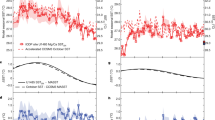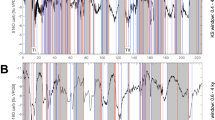Abstract
Using statistical methods we have shown quantitatively that the transition in mean and variance observed inδ 18O records during the middle of the Pleistocene was abrupt. By applying these methods to all of the available records spanning the entire Pleistocene it appears that this jump was global and primarily represents an increase in ice mass. At roughly the same time an abrupt decrease in sea surface temperature also occurred, indicative of sudden global cooling. This kind of evidence suggests a possible bifurcation of the climate system that must be accounted for in a complete explanation of the ice ages. Theoretical models including internal dynamics are capable of exhibiting this kind of rapid transition.
Similar content being viewed by others
References
Bandy OL, Casey RE, Wright RC (1971) Late Neogene planktonic zonation, magnetic reversals, and radiometric dates, antarctic to the tropics. In: J Reid (ed), Antarctic Oceanology I, Antarctic Research Series 15, American Geophysical Union, Washington, pp 1–26
Barker PF, Carlson RL, Johnson DA, Cepek P, Coulbourn W, Gamboa LA, Hamilton N, Melo U, Pujol C, Shor AN, Suzyumov AE, Tjalmsa LRC, Walton WH, Weiss W (1981) Deep sea drilling project leg 72: Southwest Atlantic paleocirculation and Rio Grande Rise tectonics. Geol Soc Am Bull 92: 294–309
Berger A (1978) A simple algorithm to compute long-term variations of daily or monthly insolation. Inst Astron Geophys G Lemaitre Contrib 18, 17 pp
Berggren WA, Phillips JD, Bertels A, Wall D (1967) Late Pliocene-Pleistocene stratigraphy in deep sea cores from the South-Central North Atlantic. Nature 216:253–255
Briskin M, Berggren WA (1975) Pleistocene stratigraphy and qualitative paleo-oceanography of tropical North Atlantic core V16-205. In: T Saito, LH Burkle (eds) Late Neogene Epoch Boundaries Micropaleontology Press: American Museum of Natural History, pp 167–198
Brunner CA, Keigwin LD (1981) Late Neogene biostratigraphy and stable isotope stratigraphy of a drilled core from the Gulf of Mexico. Mar Micropaleontol 6:397–418
Burckle LH (1977) Pliocene and Pleistocene diatom datum from the equatorial Pacific. Quat Res 7:330–340
Ciesielski PF, Ledbetter MT, Ellwood BB (1982) The development of Antarctic glaciation and the Neogene paleoenvironment of the Maurice Ewing Bank. Marine Geol 46:1–51
Cita MB, Columbo MR (1979) Late Neogene environmental evolution: quantitative micropaleontology. In: U von Rad, WBF Ryan et al. (eds) Initial Reports of the Deep Sea Drilling Project 47. US Government Printing Office Washington, pp 391–417
Cita MB, Ryan WBF (1979) Late Neogene environmental evolution. In: U von Rad, WBF Ryan et al. (eds) Initial Reports of the Deep Sea Drilling Project 47, US Government Printing Office, Washington, pp 447–459
Donahue JG (1970) Pleistocene diatoms as climatic indicators in North Pacific sediments. In: JD Hays (ed), Geological Investigations of the North Pacific, Memior 126, Geological Society of America, Washington, pp 121–138
Goossens Ch, Berger A (1986) Annual and seasonal climatic variations over the northern hemisphere and Europe during the last century. Ann Geophys 4:385–400
Hays JD (1965) Radiolaria and late Tertiary and Quaternary history of Antarctic seas. In: GA Llano (ed) Biology of the Antarctic Sea II, Antarctic Research Series 5, American Geophysical Union Washington, pp 125–184
Hays JD, Opdyke ND (1967) Antarctic radiolaria, magnetic reversals, and climatic change. Science 158:1001–1011
Hays JD, Saito T, Opdyke ND, Burkle LH (1969) Pliocene-Pleistocene sediments of the equatorial Pacific: their paleomagnetic, biostratigraphic, and climatic record. Geol Soc Am Bull 80:1481–1514
Herman Y, Hopkins DM (1980) Arctic oceanic climate in late Cenozoic time. Science 209:557–562
Hogg RV, Tanis EA (1983) Probability and Statistical Inference. Macmillan Publishing Co., Inc. New York, 533 pp
Huang TC, Watkins ND (1977) Contrasts between the Brunhes and Matuyama sedimentary records of the bottom water activity in the South Pacific. Marine Geol 23:113–132
Imbrie J, Kipp NG (1971) A new micropaleontological method for quantitative paleoclimatology: Application to a late Pleistocene Caribbean core. In: KK Turekian (ed) Late Cenozoic Ice Ages, Yale University Press, New Haven pp 71–181
Jansen E, Sejrup HP (1986) Stable isotope stratigraphy and amino-acid epimerization for the last 2.4 m.y. at Site 610, Holes 610 and 610A. In: WF Ruddiman, RB Kidd, E Thomas et al. (eds) Initial Reports of the Deep Sea Drilling Project 94, U.S. Government Printing Office Washington, pp 879–888
Karl TR, Riebsame WE (1984) The identification of 10- to 20-year temperature and precipitation fluctuations in the contiguous United States. J Climate Appl Meteorol 23:950–966
Keigwin LD (1979) Late Cenozoic stable isotope stratigraphy and paleoceanography of DSDP sites from the East Equatorial and Central North Pacific ocean. Earth Planet Sci Lett 45:361–382
Kennett JP (1970) Pleistocene paleoclimates and foraminiferal biostratigraphy in subantarctic deep-sea cores. Deep-Sea Res 17:125–140
Kent D, Opdyke ND, Ewing M (1971) Climate change in the north Pacific using ice-rafted detritus as a climatic indicator. Geol Soc Am Bull 82:2741–2754
Koizumi I (1986) Pliocene and Pleistocene diatom datum levels related with paleoceanography in the Northwest Pacific. Marine Micropaleontol 10:309–325
Larson HJ (1982) Introduction to Probability Theory and Statistical Inference. John Wiley and Sons, New York, 637 pp
Mann HB (1945) Non-parametric test against trend. Econometrika 13:245–259
Peterson LC, Lohmann GP (1982) Major change in Atlantic deep and bottom waters 700 000 yr ago: Benthonic foraminiferal evidence from the South Atlantic. Quat Res 17:26–38
Phillips JD, Berggren WA, Bertels A, Wall D (1968) Paleomagnetic stratigraphy and micropaleontology of three deep sea cores from the Central North Atlantic ocean. Earth Planet Sci Lett 4:118–130
Pisias NG, Moore TC (1981) The evolution of Pleistocene climate: A time series approach. Earth Planet Sci Lett 52:450–458
Prell WL (1982) Oxygen and carbon isotope stratigraphy for the Quaternary of hole 502b: Evidence for two modes of isotopic variability. In: WL Prell, GV Gardner (eds), Initial Reports of the Deep Sea Drilling Project 68, U.S. Government Printing Office, Washington, pp 455–464
Ruddiman WF (1971) Pleistocene sedimentation in the Equatorial Atlantic: Stratigraphy and faunal paleoclimatology. Geol Soc Am Bull 82:282–302
Ruddiman WF, McIntyre A, Raymo M (1986a) Paleoenvironmental results from North Atlantic Sites 607 and 609. In: WF Ruddiman, RB Kidd, E Thomas et al. (eds), Initial Reports of the Deep Sea Drilling Project 94, U.S. Government Printing Office, Washington, pp 855–878
Ruddiman WF, Raymo M, McIntyre A (1986b) Matuyama 41 000-year cycles: North Atlantic ocean and northern hemisphere ice sheets. Earth Planet Sci Lett 80:117–129
Saltzman B, Hansen AR, Maasch KA (1984) The late Quaternary glaciations as the response of a three-component feedback system to earth-orbital forcing. J Atmos Sci 41:3380–3389
Saltzman B, Sutera A (1987) The mid-Quaternary climatic transition as the free response of a three-variable dynamical model. J Atmos Sci 44:236–241
Shackleton NJ, Cita MB (1979) Oxygen and carbon isotope stratigraphy of benthic foraminifers at Site 397: Detailed history of climatic change during the late Neogene. In: U von Rad, WBF Ryan et al. (eds), Initial Reports of the Deep Sea Drilling Project 47, US Government Printing Office, Washington, pp 433–445
Shackleton NJ, Hall MA (1983) Stable isotope record of Hole 504: High resolution record of the Pleistocene. In: JR Cann, MG Langseth et al. (eds), Initial Reports of the Deep Sea Drilling Project 69, US Government Printing Office, Washington, pp 431–441
Shackleton NJ, Hall MA (1984) Oxygen and carbon isotope stratigraphy of deep sea drilling project Hole 552A: Plio-Pleistocene glacial history. In: DG Roberts, D Schnitker et al. (eds), Initial Reports of the Deep Sea Drilling Project 81, US Government Printing Office, Washington, pp 599–609
Shackleton NJ, Kennett JP (1975) Late Cenzoic oxygen and carbon isotopic changes at DSDP Site 284: Implications for glacial history of the Northern Hemisphere and Antarctica. In: JP Kennett, RE Houtz et al. (eds), Initial Reports of the Deep Sea Drilling Project 29, US Government Printing Office, Washington, pp 801–807
Shackleton NJ, Opdyke ND (1976) Oxygen-isotope and paleomagnetic stratigraphy of Pacific core V28-239 late Pliocene to latest Pleistocene. In: RM Cline, JD Hays (eds), Investigations of Later Quaternary Paleoceanography and Paleoclimatology, Memior 145, Geological Society of America, Washington, pp 449–464
Sneyers R (1963) Sur la détermination de la stabilité des seriés climatologiques. Proceedings UNESCO-WMO Symposium on Changes of Climate, Unesco Arid Zone Research Series 20:37–44
Sneyers R (1975) Sur l'analyse statistique des séries d'observations. Technical Note 143, WMO, Geneva
Start GG, Prell WL (1984) Evidence for two Pleistocene climatic modes: Data from DSDP Site 502. In: AL Berger, C Nicolis (eds), New Perspectives in Climate Modelling, Developments in Atmospheric Science 16, Elsevier, Amsterdam New York, pp 3–22
Thunnell RC (1979) Climatic evolution of the Mediterranean Sea during the last 5.0 million years. Sediment Geol 23:67–79
Thunnell RC, Williams DF (1983) Stepwise development of Pliocene-Pleistocene paleoclimatic and paleoceanographic conditions in the Mediterranean: Oxygen isotope studies of DSDP Sites 125 and 132. Utrecht Micropaleontol Bull 30:111–127
van Donk J (1976) O18 record of the Atlantic ocean for the entire Pleistocene epoch. In: RM Cline, JD Hays (eds), Investigations of Late Quaternary Paleoceanography and Paleoclimatology, Memior 145, Geological Society of America, Washington, pp 147–163
Williams DF (1985) Carbon isotope variations in surface waters of the Gulf of Mexico on time scales of 10000, 30000, 150000, and 2 million years. In: ET Sundquist, WS Broecker (eds), The Carbon Cycle and Atmospheric CO2: Natural Variations Archean to Present, Geophysical Monograph 32, American Geophysical Union, Washington, pp 329–341
Worsley TR, Herman Y (1980) Episodic ice-free Arctic Ocean in Pliocene and Pleistocene time: Calcareous nannofossil evidence. Science 210:323–325
Yamamoto R, Iwashima T, Sanga NK, Hoshiai M (1986) Analysis of climatic jump. J Meteorol Soc Jap 64:273–280
Author information
Authors and Affiliations
Rights and permissions
About this article
Cite this article
Maasch, K. Statistical detection of the mid-Pleistocene transition. Climate Dynamics 2, 133–143 (1988). https://doi.org/10.1007/BF01053471
Received:
Accepted:
Issue Date:
DOI: https://doi.org/10.1007/BF01053471




